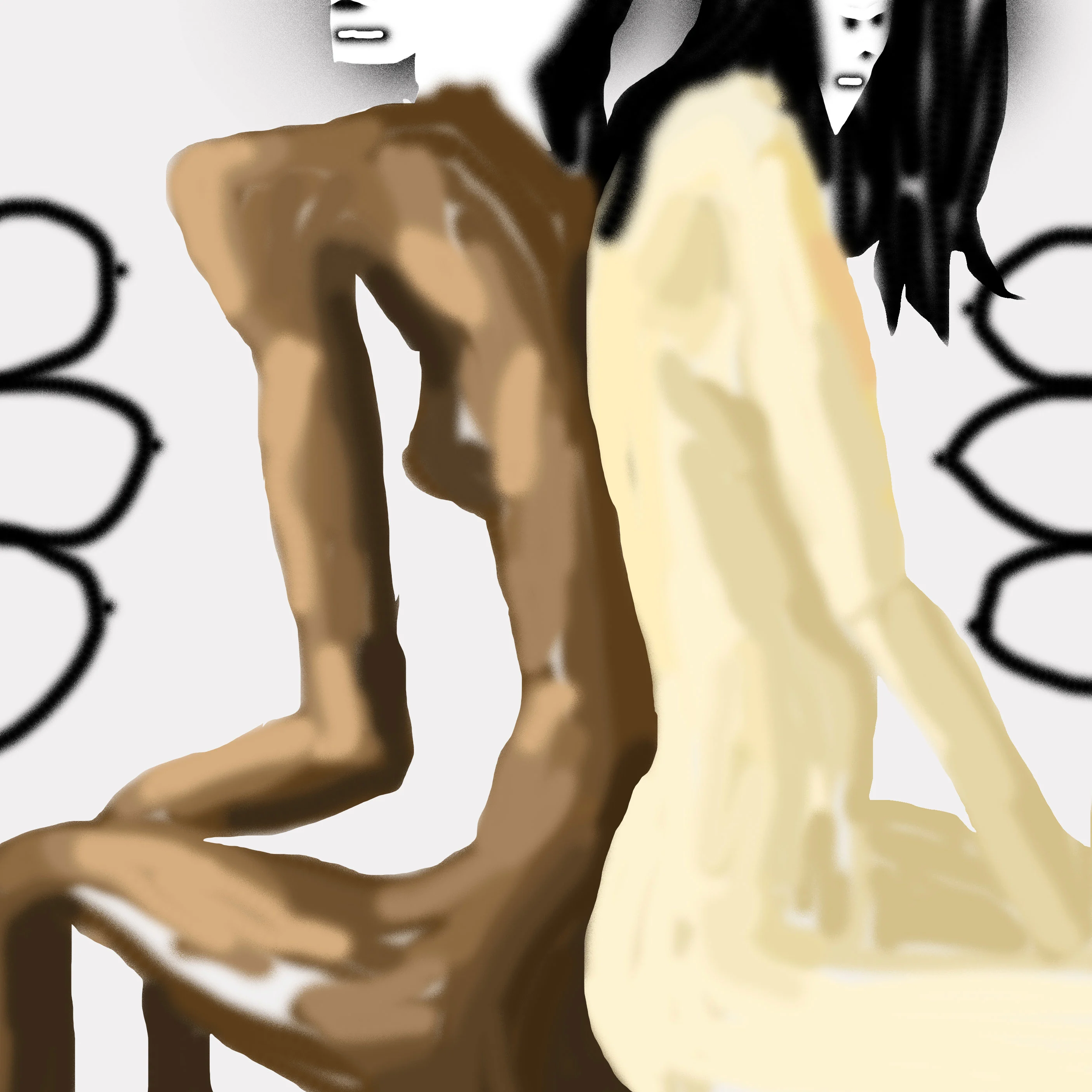

The worlds Alexey Shahov creates look like video games that are still in the process of being designed, as grey, uneven body parts with stickman-like features are partially covered by sprawling flashes of spray paint and pencil marks. What does it all mean? Even Alexey doesn’t know just yet. He tells Alex Kahl why he can never settle on a single medium, and why his pieces might always appear unfinished.

Alexey Shahov was born in Kyrgyzstan, and emigrated to the Czech Republic with his family at the age of 12. His mother was a fashion designer who spent a lot of time sketching, but besides his own brief forays into drawing, art didn’t play a big part in his early life. His family didn’t travel at all, so his time was almost entirely spent in the small towns they lived in, often in front of the television. “All I ever knew about life, about Western culture or about art, I learned through the TV,” he says.

All I know about life, I learned through the television.
Gradually, he became more interested in art, and his first attempts were based on his love of classical painting. Today though, his work is far from that early influence. He paints and draws in his own unique style. He almost always depicts strange, disfigured faces and bodies surrounded by abstract shapes, with greys, whites and blacks the dominant colors and splashes of brighter hues popping up every so often. Faces overlap faces and body parts jut out in different directions. Some of the figures look like ghosts, others look possessed by some evil force. Some look like unfinished characters from ancient video games. Some of the faces look familiar, as if you might have seen them in some old cartoon. This looks like the work of a man who got to know the world through a TV screen for most of his childhood.



He often starts on Photoshop, drawing portraits of characters and mixing those with abstract shapes and structures. He adds multiple layers, making some fade into the background and others stand out with bold, crisp outlines. “I love working digitally because you can start with a shape and just completely transform it, and every time it’s different from the last,” he says. “I never use a template. It all comes from my imagination.” Alexey will share some of these pieces in their original form as digital sketches, but sometimes he projects them to create stencils and recreates them using spray paint on paper. Sometimes he adds licks of acrylic paint to these while for other works he uses spray paint on planks of wood. He can never quite decide exactly what medium wants to pursue. It’s all intuitive for Alexey; whatever feels right at the time, he’ll do, and he doesn’t dwell too much on a single piece before moving onto the next.

He doesn’t give himself a second take at any piece he does; the first take is the only take. What’s more, despite being left-handed, he uses his right hand on a touchpad for digital drawings. “I tried to use a stylus but it didn’t work,” he laughs. He often makes sizable mistakes with spray paint. “But I realized I preferred that to making really perfect pictures,” he says. Choosing to use his weaker hand, taking every first draft as the final piece, these are not the most perfect artworks Alexey could’ve made, but they were never supposed to be.


“I never liked these photo-realistic paintings. I always preferred imperfect paintings and images,” he says. “I was inspired by the impressionists who began to turn away from the traditional style and the academic norms.” Alexey’s work is influenced by ancient artwork, the style of prehistoric painting that might be found on the walls of caves from tens of thousands of years ago, and this comes through in his work, as sprawling paint marks seem to appear randomly. He’s fascinated by art that clearly shows the process of how it was made, like the work of sculptors such as Huma Bhabha and Thomas Houseago. “They use different construction materials, and in the final product, you can see the raw materials. The sculptures are never perfect. They always look like they’re not quite finished,” he says.

Alexey thinks he might prefer to leave his work incomplete because his understanding of himself isn’t quite complete either. Having to leave his home country with his family at the age of 12 was hard on him, and he also grew up without a father figure in his life. “I think because of that, some learnings about the way the world works simply passed me by,” he says. “Maybe that anxiety and uncertainty inside me leads to all of this unfinished work.”


I love working digitally. Every piece is different from the last.
He’s also not sure of the meaning behind his work. “I’m fascinated by artists that work according to a concept or a story,” he says. “I just see some composition or some shapes, and I modify them. I put them together and try some things and just see what happens.” He admits that his work probably does say something about his mind without him realizing it. “I know there’s something deep inside me, somewhere in my subconscious, but I can’t explain it in an easy way. I’m sure a psychologist could take one look at these pictures and say something about me,” he laughs. He speaks about the Rorschach test, which involves psychologists showing patients vague shapes and pictures and asking them what they see, and Alexey’s work would probably be perfect for this. Devoid of any particular story of overt theme, it’s up to the viewer to decide which layer of spray paint or digital pencil mark they want to focus on. So, take a look. Whether you see grimacing demons or smiling cartoons is down to you.






